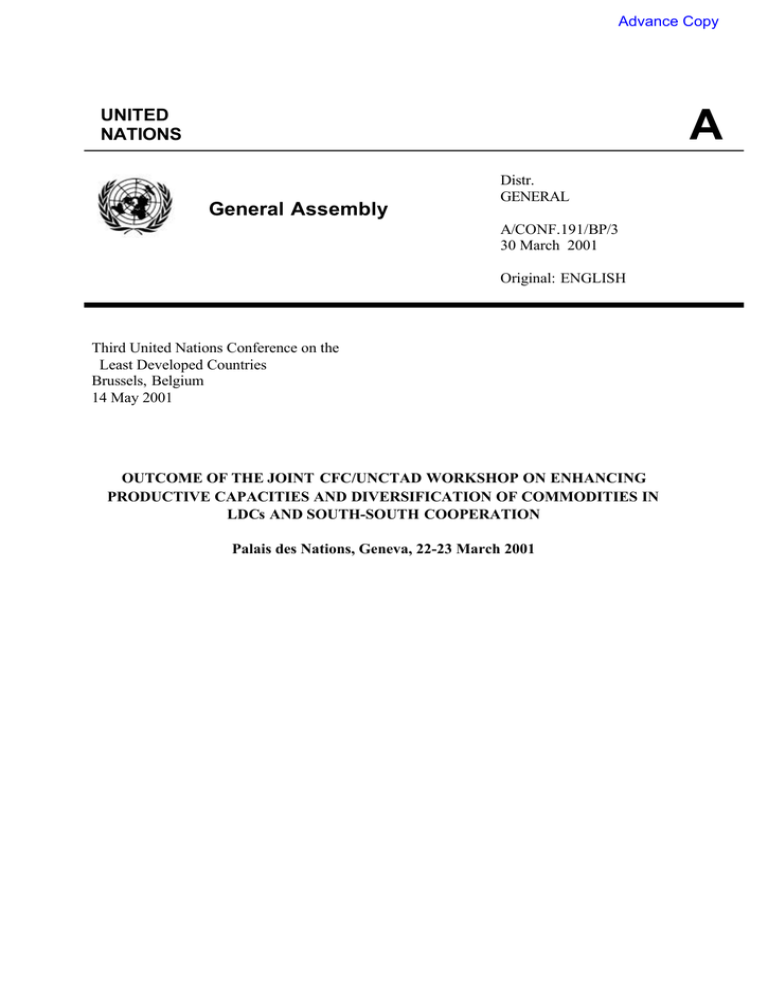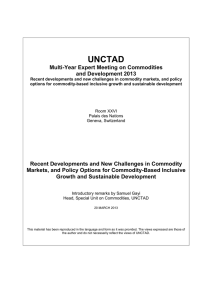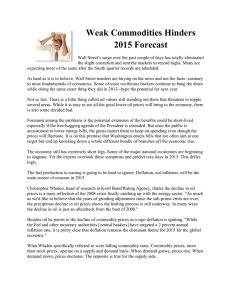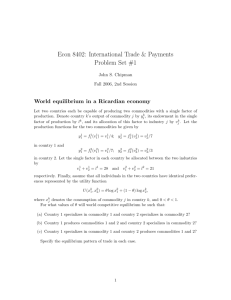A General Assembly UNITED NATIONS
advertisement

Advance Copy UNITED NATIONS A General Assembly Distr. GENERAL A/CONF.191/BP/3 30 March 2001 Original: ENGLISH Third United Nations Conference on the Least Developed Countries Brussels, Belgium 14 May 2001 OUTCOME OF THE JOINT CFC/UNCTAD WORKSHOP ON ENHANCING PRODUCTIVE CAPACITIES AND DIVERSIFICATION OF COMMODITIES IN LDCs AND SOUTH-SOUTH COOPERATION Palais des Nations, Geneva, 22-23 March 2001 A/CONF.191/BP/3 Page 2 JOINT CFC / UNCTAD WORKSHOP ON “ENHANCING PRODUCTIVE CAPACITIES AND DIVERSIFICATION OF COMMODITIES IN LDCS AND SOUTH-SOUTH CO-OPERATION” 1. The Joint CFC/UNCTAD Workshop on Enhancing Productive Capacities and Diversification of Commodities in LDCs and South-South Co-operation was held at the Palais de Nations, Geneva, from 22 to 23 March 2001. The Workshop was attended by delegates from 24 LDCs, 11 other countries and the European Union, and 10 delegates from international commodity bodies (ICBs) and other international organisations. H.E. Mr. Retselisitsoe Victor Lechesa, Ambassador of Lesotho, was elected Chairman of the Meeting. 2. Opening addresses to the Workshop were made by Mr. Rubens Ricupero, SecretaryGeneral, UNCTAD, and Mr. Rolf W. Boehnke, Managing Director, CFC. Four thematic presentations were made during the Workshop which were followed by discussions: - Enhancing Productive Capacities and Competitiveness; Vertical, Horizontal and Geographical Diversification of Commodities; Commodity Market Development; Structured Commodity Finance, Price Risk Management and Commodity Development Financing and Foreign Direct Investment (FDI). 3. Country representatives from LDCs made brief presentations on the role of commodities in their economies and specific problems and constraints faced by them in developing the commodity sector in their countries. 4. Role of Commodities: Most of the economies of the participating countries depend heavily on the commodity sector, with agriculture and fisheries contributing over 36% of GDP and over 80% of export earnings. More than 70% of their population is essentially employed in primary commodity production, with a major part engaged in subsistence farming. 5. The countries produce a range of agricultural commodities contributing in various proportions to their export earnings. Major export commodities include bananas, cashew, cereals, cocoa, coffee, cotton and cotton seed, cut flowers, fonio, fish and marine products, ground nuts, gum arabica, hides and skins, horticultural products (beans, fresh chillies, onions etc), live animals, medicinal plants, pulses, oilseeds, oil palm, rice, spices, tobacco, tropical fruits and tubers. However, two or three commodities account for the bulk of each LDC’s export trade, a single commodity often accounting for over 60% of export earnings. 6. Prevailing Production Methods: The social aspects of LDCs’ agriculture are predominantly those of individual households using family labour on small plots. Simple commodity production had beem developed on a slash and burn basis using primitive farming techniques. With limited areas available for agricultural expansion under this method of cultivation, output has failed to keep pace with population growth and hence has been unable to allow food self-sufficiency and export expansion. Both subsistence and smallholder-based A/CONF.191/BP/3 Page 3 commodity production are heavily dependent on rain-fed agriculture. Most LDCs are exposed to the vagaries of climatic and other natural calamities. Lack of agricultural inputs, including improved seeds, fertilisers and disease control chemicals, are some of the major constraints on improving agricultural productivity. The absence of adequate extension services and research and development capacities have limited the spread and adoption of modern agricultural production techniques, impacting negatively on the quality of commodities. 7. Other Major Constraints of the Commodities Sector: The most important constraints are price and earnings volatility and the susceptibility of the commodity dependent countries to developments in international commodity and financial markets. This is particularly linked to the heavy reliance on a small range of commodities. They are also vulnerable when plantations are damaged by various causes or become less productive due to genetic wear, as in the case of tree crops. Most of these countries, therefore, pursue diversification strategies of their export crops. Linked to the smallholder-based production and marketing structure is the low quality of the products, which are often sold at discounted prices. Market access is often barred due to inability to meet prescribed sanitary and phytosanitary (SPS) as well as other technical standards. With regard to market access, while appreciating initiatives already taken in favour of LDCs, it was felt that more should be done. Furthermore, LDC products often suffer from lack of competitiveness due to the high costs of production, transportation and marketing. Lack of well developed physical infrastructure not only causes deterioration in quality, but also heavy losses in value due to spoilage and delays in delivery. Many LDCs have the disadvantage of being insular or landlocked, in addition to having weak infrastructure. 8. With a view to achieving sustainable and equitable development and reducing poverty, the LDC participants in the Workshop recommended actionable measures in the following broad areas: 8.1. Enhancing Productive Capacities - 8.2. Transfer and adoption of suitable production technologies, including for small-scale operations; Strengthening research and development capacities in LDCs; Availability of improved seeds and planting material at the local or regional level; Institutional and human capacity building; Investment in supportive infrastructure. Quality and Safety Standards - Harmonization of national and regional standards; Building of national and regional capacity for testing and certification. A/CONF.191/BP/3 Page 4 8.3. Post Harvest Measures - 8.4. Horizontal and Vertical Diversification - 8.5. - Product differentiation and development of niche markets (“decommoditization” of commodities); Entering new regional markets and development of the home market; Market information and commodity exchanges; Ways of addressing the transport cost and other disadvantages of landlocked and small island countries. Financing - 8.7. Assessment of the feasibility of horizontal and vertical commodity diversification; Expansion of production and trade in non-traditional commodities; Value addition through local processing, particularly at the small and medium scale level; Development of new uses; Valorisation of by-products and co-products. Marketing - 8.6. Appropriate post harvest treatment and storage so as to reduce losses. Availability of input credit for small farmers; Use of warehouse receipts to facilitate the access to and reduce the cost of finance; Price risk management to mitigate the effects of volatile commodity markets; Creating enabling conditions to attract foreign direct investment (FDI). Strategic Partnerships - Complementarity of actions of all developmental partners covering the whole production and marketing chain, taking into account the Integrated Framework for Trade-Related Technical Assistance to the LDCs. 9. The Common Fund for Commodities, UNCTAD and other multilateral as well as bilateral development institutions are asked to support projects in the above-mentioned areas.




